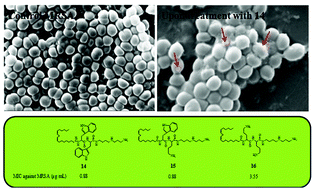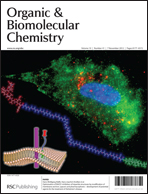Synthesis, antibacterial activity and mode of action of novel linoleic acid–dipeptide–spermidine conjugates†
Abstract
Towards therapeutically viable mimics of host defense cationic peptides (HDCPs) here we report the design and synthesis of a small library, based on a novel hydrophobic–dipeptide–spermidine template. Lipidated sequences 11, 14, 15, 16, 18 and 19 exhibited potent activity against susceptible as well as drug resistant Gram-positive and Gram-negative bacterial strains. Structure–activity relationships of the template revealed a hydrophobicity window of 50–70% with minimum +2 charges to be crucial for activity and cell selectivity. Active sequences 14, 15 and 16 exhibited different modes of action based on dipeptide composition as revealed by studies on model membranes, intact bacterial cells and DNA. Further, severe damage to surface morphology of methicillin resistant S. aureus caused by 14, 15 and 16 at 10 × MIC was observed. The present study provides us two active sequences (14 and 16) with a membrane perturbing mode of action, cell selectivity to hRBCs and keratinocytes along with potent activity against clinically relevant pathogen MRSA. The designed template thus may prove to be a suitable probe to optimize sequences for better selectivity and potential to combat a wide range of drug resistant strains in further research.


 Please wait while we load your content...
Please wait while we load your content...